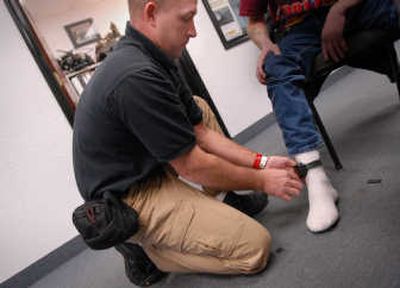Keeping tabs electronically on more sex offenders

OLYMPIA – A few weeks ago, state corrections officials were surprised to see that a Spokane sex offender named Carleton Sylvester Smith apparently spent a cold, rainy day hanging out in an industrial area near East Sprague.
How did they know? From the electronic tracking device on Smith’s ankle. Under questioning the next day, the 43-year-old allegedly revealed he’d been lurking near a day-care center, “participating in some deviant behavior” solo, according to Maria Peterson, a spokeswoman for the department.
“He was watching the people who would come in and out, particularly probably the women who would come in and pick up their kids,” said Alice Watts, a state Department of Corrections official in Spokane whose office monitors Smith and others.
Smith, a convicted child molester barred from parks, playgrounds and schools, was immediately arrested and sent back to jail. On Thursday, he was still in a cell in Benton County, pending a hearing.
It was a textbook case, corrections officials say, of the effectiveness of a system that Gov. Chris Gregoire and some lawmakers want to see more of: using satellites and computers to track the most dangerous sex offenders in communities.
Gregoire next week will release a 2008 budget proposal that will include about $8 million for a wide variety of stepped-up monitoring of sex offenders, including nearly $1 million for more electronic monitoring. Three months ago, Gregoire tapped her emergency fund for money to start putting a handful of level 3 sex offenders on monitoring. She hopes to have 150 more on the tracking system over the next year and a half.
“As a mother and as governor, I am absolutely committed to protecting our children and communities from sex offenders,” she said.
In Spokane, state corrections officials have been using electronic tracking on a small number of particularly dangerous offenders for about five years.
“We were one of the first ones in the state that did it,” said Watts, who supervises community corrections at Spokane’s community justice center. At any given time, she said, they’re tracking six or eight people. Not all are sex offenders. One is an arsonist with a propensity for getting drunk and lighting fires.
“We keep him on this all summer long,” Watts said of the monitor.
For most, she said, the deterrent effect of a tracking device clamped on one’s leg seems to work. Some – like Smith, she said – show “intractable behavior” and will violate the terms of their release from prison even though they know it’s likely they’ll be caught.
Some lawmakers say the technology is so promising that it should be deployed much more widely. A month before the legislative session begins in Olympia, 21 House lawmakers have signed onto a bill that would expand the satellite tracking to every level 3 sex offender on state supervision now or in the future. That’s about 326 people now, according to statistics from the Department of Corrections. The bill also would require tracking potentially hundreds more sex offenders who register as homeless or have failed to register.
That’s too much too fast, said Don Pierce, executive director of the Washington Association of Sheriffs and Police Chiefs. The group is helping the state set up the tracking system.
“The worst thing we could do would be to give our citizens an expectation of security that we can’t deliver,” he said. “The states that have gone to putting 4,000 or 6,000 sex offenders on GPS tracking don’t have half of them on the system a year and a half later.”
And there are a lot of sex offenders out there. As of Tuesday, the state was supervising 3,333 of them. Of those, 233 are in Spokane County. But those are just the ones on active supervision. There are more than 20,000 sex offenders in the state, according to Anna Aylward, program administrator for sex offenders at the Department of Corrections. The vast majority of those are not being supervised at all. And it’s unlikely the state could constitutionally order monitoring for those who’ve served their sentences and are no longer supervised, Pierce said.
The best approach, he said, is to let local authorities decide whom to monitor and how intensively. It takes considerable time, Pierce said, for community corrections officers to monitor the mapping system and question people. Slowly ramping up the system makes the most sense, he said.
“But you’ve got to start somewhere,” he said. “And these are the right people.”